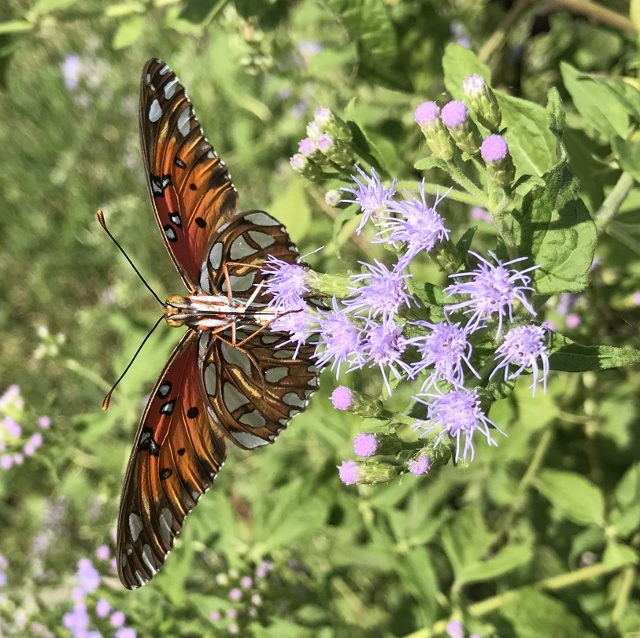— Bring in the butterflies with just a couple of plants
Story and photos by Anita Westervelt, Texas Master Naturalist

September’s rains provided a tremendous boost to our fall kaleidoscope of butterflies.
What’s rain got to do with it? September rains create a burst of blooms in our native plant communities — in time for our annual October butterfly surge. More blooms, more butterflies. The opposite is true in drought years. No rain, no blooms, no butterflies; they go elsewhere to seek nectar for survival.
Just three or four plants are enough to attract a variety of butterflies. Visit a local nursery or native plant grower and buy native plants that are blooming now. Water them in well when planting. If it is unseasonably hot, water the new plants every day for a week or so to help them establish.
Oranges, yellows, reds and purples are colors blooming now — but plants aren’t created equal in the nectar department. A useful spreadsheet to download for Rio Grande Valley butterfly native nectar plants is at the following National American Butterfly Association link:
https://naba.org/chapters/nabast/plants_info.pdf. Nectar categories are excellent, good, fair, and poor.
Two popular red-blooming plants are scarlet sage (Salvia coccinea), listed as good nectar and Turk’s cap (Malvaviscus drummondii), with an excellent nectar rating. These plants love full sun to partial shade, will bloom through winter and are ardent self-propagators. They attract hummingbirds as well as butterflies. Plant them where you can quietly observe the winged visitors. Great kiskadees have been known to hop up and pluck a round white fruit from a Turk’s cap bush.
Another small native shrub in the excellent nectar category is purple-blooming fall mistflower, (Chromolaena odorata), also called crucita. This is a must-have plant to bring in multiple species of butterflies. As a matter of fact, if you have room for only one plant, make it a fall-blooming mistflower; it comes into its blooming glory in October, attracting heliconian butterflies, patches, hairstreaks, skippers, queens, emperors, fritillaries, swallowtails and more. Plant in full or partial sun. The shrub can get ungainly after the blooms are spent but it is easily cut back or removed. It self-propagates if kept long enough for the seeds to mature.

Consider one or more of the prolific-blooming lantanas for excellent nectar. Multi-colored in orange, yellow and red, Texas lantana (Lantana urticoides) adds vibrant color to the landscape. Pink and yellow blooming West Indian lantana (Lantana camara) offers a more pastel palette. Velvet lantana (Lantans velutina) has white blooms. It is a more compact and shapely shrub than Texas or West Indian lantana, and it will bloom well into the winter.
Another white-blooming small shrub, heliotrope (heliotropium angiospermum), is an all-time butterfly favorite drawing a rabble of small butterflies. It has an excellent nectar rating. On a sunny day, heliotrope, also called scorpion’s tail, will be busy with white peacock butterflies, common mestras, little yellow sulphurs, duskywings, metalmarks, checkerspots and blues. Heliotrope blooms in all seasons and readily reseeds itself.
Once established, native plants require little care and can survive with minimal water. For a list of local native plant growers visit: https://rgvctmn.org/rgv-plants/

– 30 –
